Polly
Stella Park
14 11 18 12:15 Filed in: Young Adults 1970s
Guelda and Polly Pyke were Jono’s father’s first cousins; and were always very much part of Jono's and his sister Anne's life.
Polly was the eldest and an eccentric character with a dry quick wit. Her sister Guelda, also eccentric, was an artist and part of the vibrant Melbourne art scene in the late 40’s and 50’s.
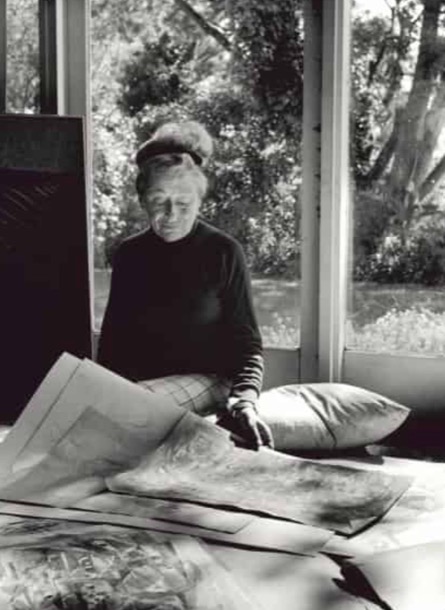
Guelda in her studio

A still life by Guelda
At this time Melbourne was awash with new modernist ideas in the arts and architecture. Guelda was taught by George Bell, one of the early modernist painters. In these classes she mixed with other influential young painters of the day, some of whom remained lifelong friends. It was likely that through this group Guelda met Alistair Knox, an emerging young architect, who the sisters commissioned to design their house at Templestowe.
Polly and Guelda with two other friends, also sisters, bought a working apple and peach orchard in Templestowe. Stella Park, as it was called, was named after the orchardists’s wife.They were not alone in moving to the outer suburbs, as the area was becoming a favourite with many young artists. John and Sunday Reid had already established their retreat at Heide, where they nurtured a circle of artists, writers and intellectuals. Heidi had become a place for the discussion, creation and promotion of modern art and literature. Alistair Knox was also working in the area, known especially for his mud brick houses.
The RMIT Design Archives have in Knox’s words a description of the project at Stella Park.
Knox reminisces:
One day in 1948 I was approached by an executive of the Art Gallery of Victoria on behalf of four ladies who proposed to build three houses on a twenty-acre peach and apple orchard in Templestowe - a joint house for Polly and Guelda Pyke, and separate ones for Val and Yvonne Cohen. They were all unmarried at this stage, although Val was anticipating marriage in the near future and her mother proposed to live with Val's sister Yvonne in the second house. As the Pykes' was a joint building, the two women decided to occupy separate sections of the building, especially as Guelda required a private area for her work as a practising artist. They had independent means, and this gave me my first opportunity to produce three sizeable houses amid the pink and white plum blossoms that covered the northern slope and looked over the river towards Eltham. It was an idyllic scene, particularly as these would be almost the first houses that could be seen from that direction. This was before any orchards had been subdivided, and the unbroken pattern of fruit trees separated by lines of ancient pines had remained unaltered since the land was first settled by a largely German community a hundred years earlier.
I had opted for timber construction on concrete slabs because there was a slight improvement in the supply position and because I thought earth-building would prove too great a strain on my elegant artistic lady clients, no matter how they thought about it before it all began.
https://alistairknox.org/buildings/64
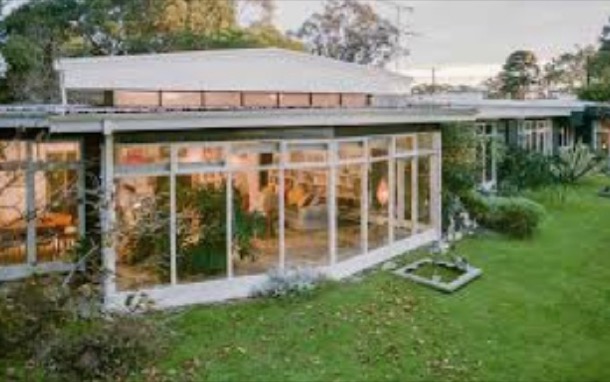
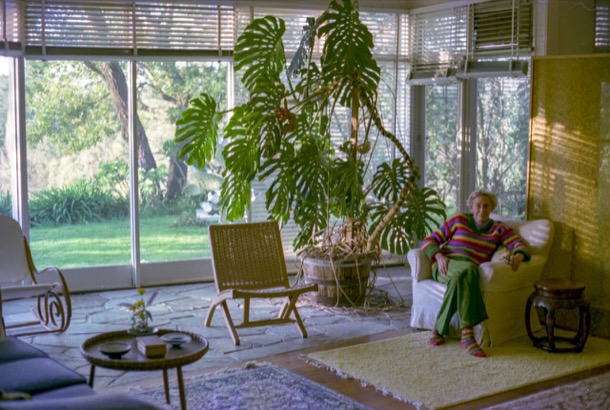
Polly in her lounge room (Photo by Fred)
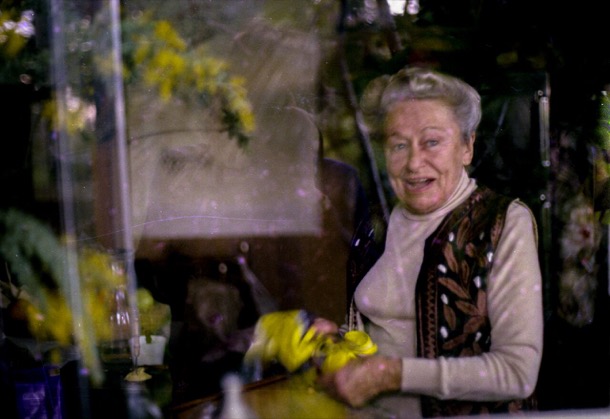
Guelda in her kitchen (Photo by Fred)
Stella Park was very much part of Jono’s childhood. Below he has recorded his memories of that special place.
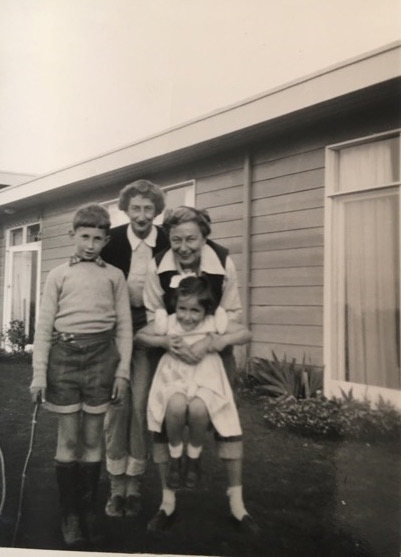
Left to right: Jono, Polly, Guelda, Anne, in the garden soon after the house was built.
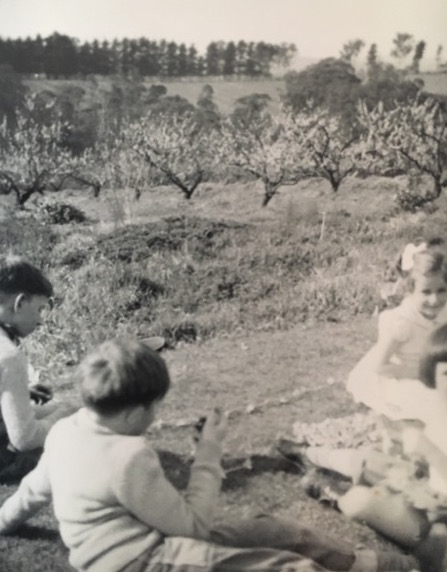
Anne, Jono and friends in the orchard.
Anna and Thomas and I were also lucky to have experienced visits to Polly and Guelda at Templestowe. We too loved sitting on the floor at Guelda’s end eating hot chutney, Guelda bread and other assorted goodies, exploring the house and garden and walking to the Yarra.

Anna, Thomas and friends
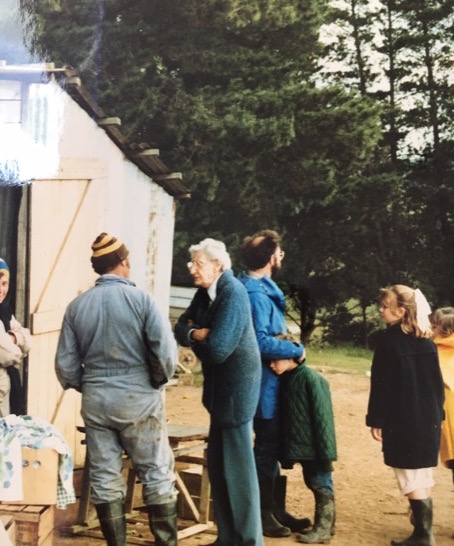
Left to right: Pasquale, local vegetable grower, Polly, Jono, Thomas and friend
Stella Park was an ambitious enterprise for four very adventurous women. Polly and Guelda both loved their part of it. They lived there until in their eighties they could no longer look after the property. We were lucky to have have known it.
Polly was the eldest and an eccentric character with a dry quick wit. Her sister Guelda, also eccentric, was an artist and part of the vibrant Melbourne art scene in the late 40’s and 50’s.

Guelda in her studio

A still life by Guelda
At this time Melbourne was awash with new modernist ideas in the arts and architecture. Guelda was taught by George Bell, one of the early modernist painters. In these classes she mixed with other influential young painters of the day, some of whom remained lifelong friends. It was likely that through this group Guelda met Alistair Knox, an emerging young architect, who the sisters commissioned to design their house at Templestowe.
Polly and Guelda with two other friends, also sisters, bought a working apple and peach orchard in Templestowe. Stella Park, as it was called, was named after the orchardists’s wife.They were not alone in moving to the outer suburbs, as the area was becoming a favourite with many young artists. John and Sunday Reid had already established their retreat at Heide, where they nurtured a circle of artists, writers and intellectuals. Heidi had become a place for the discussion, creation and promotion of modern art and literature. Alistair Knox was also working in the area, known especially for his mud brick houses.
The RMIT Design Archives have in Knox’s words a description of the project at Stella Park.
Knox reminisces:
One day in 1948 I was approached by an executive of the Art Gallery of Victoria on behalf of four ladies who proposed to build three houses on a twenty-acre peach and apple orchard in Templestowe - a joint house for Polly and Guelda Pyke, and separate ones for Val and Yvonne Cohen. They were all unmarried at this stage, although Val was anticipating marriage in the near future and her mother proposed to live with Val's sister Yvonne in the second house. As the Pykes' was a joint building, the two women decided to occupy separate sections of the building, especially as Guelda required a private area for her work as a practising artist. They had independent means, and this gave me my first opportunity to produce three sizeable houses amid the pink and white plum blossoms that covered the northern slope and looked over the river towards Eltham. It was an idyllic scene, particularly as these would be almost the first houses that could be seen from that direction. This was before any orchards had been subdivided, and the unbroken pattern of fruit trees separated by lines of ancient pines had remained unaltered since the land was first settled by a largely German community a hundred years earlier.
I had opted for timber construction on concrete slabs because there was a slight improvement in the supply position and because I thought earth-building would prove too great a strain on my elegant artistic lady clients, no matter how they thought about it before it all began.
https://alistairknox.org/buildings/64


Polly in her lounge room (Photo by Fred)

Guelda in her kitchen (Photo by Fred)
Stella Park was very much part of Jono’s childhood. Below he has recorded his memories of that special place.

Left to right: Jono, Polly, Guelda, Anne, in the garden soon after the house was built.

Anne, Jono and friends in the orchard.
Anna and Thomas and I were also lucky to have experienced visits to Polly and Guelda at Templestowe. We too loved sitting on the floor at Guelda’s end eating hot chutney, Guelda bread and other assorted goodies, exploring the house and garden and walking to the Yarra.

Anna, Thomas and friends

Left to right: Pasquale, local vegetable grower, Polly, Jono, Thomas and friend
Stella Park was an ambitious enterprise for four very adventurous women. Polly and Guelda both loved their part of it. They lived there until in their eighties they could no longer look after the property. We were lucky to have have known it.
Comments
Drouin Christmas, 1975
03 10 18 14:32 Filed in: Young Adults 1970s
The Christmas of 1975 was a huge and exciting enterprise. Jono and I were living in a beautiful house just outside Drouin. It was the old farmhouse on a big dairy farm for which we paid the princely sum of $10 a month rent. It was the perfect venue for an Australian Christmas for Jono’s visiting Danish relatives.
Guelda, Jono's cousin had made contact with the Danish relatives before World War 2, and the families had maintained contact ever since. Eva and Harry lived in Copenhagen, and Jono and I, Anne and Janey had all stayed with them the previous year. Now it was our turn to host.
In retrospect, it was very ambitious. We had Christmas lunch to prepare for Jono's and my immediate families, Guelda and her sister Polly, the Danes and a couple of teaching friends: seventeen in all. We also had several of the party as house guests overnight, before the culmination of Boxing Day’s lunch of leftovers, and the Drouin Picnic Races. Everybody chipped in as usual and it was a great success. The whole two day event was beautifully photographed and filmed by Fred, as always. These images have recently been sent to us, as Fred goes through his archives.
Guelda, Jono’s cousin must have been in her sixties in this photograph. Always eccentric and her own person, she did not disappoint at this party. She sunbaked topless, wore wonderfully bright, way-out clothes and was the life of the party. Guelda already knew Eva and Harry quite well from her many trips to Denmark so they were very pleased to see each other.
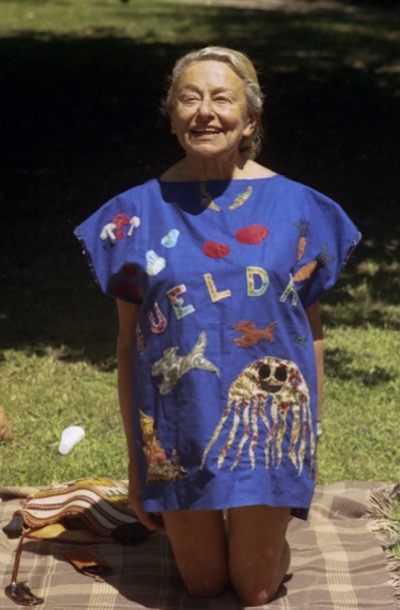
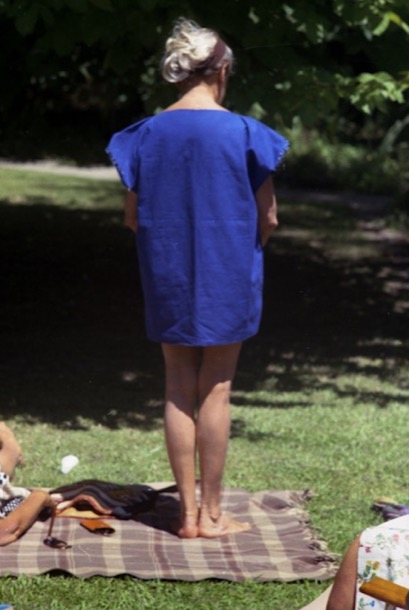
This was a lovely room with big windows opening to a verandah and a large shady Golden Elm. Jono and I painted this room to brighten it up, when we took the house. You can see on the mantlepiece some of the pots we still have, and on the chair our secondhand black and white television.

Harry and Eva married late in life and lived in an apartment in central Copenhagen. They were a couple of contrasts. Eva was an imposing, vibrant, woman with a booming deep voice and Harry was a quiet and gentle man with a weakness for Blue Castello cheese. He introduced it to us in Denmark and we have been buying it ever since.
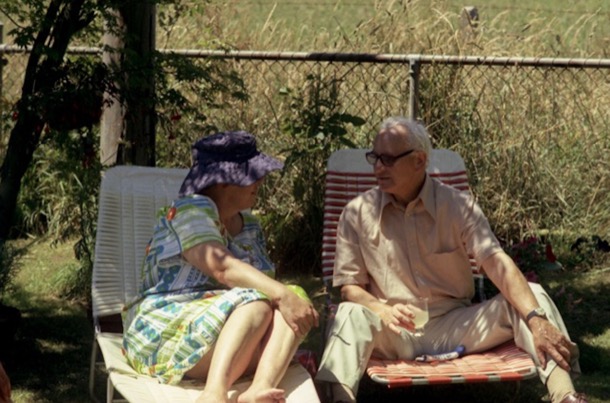
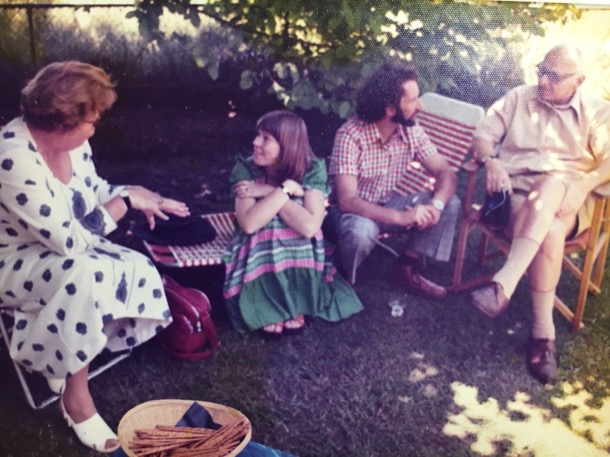
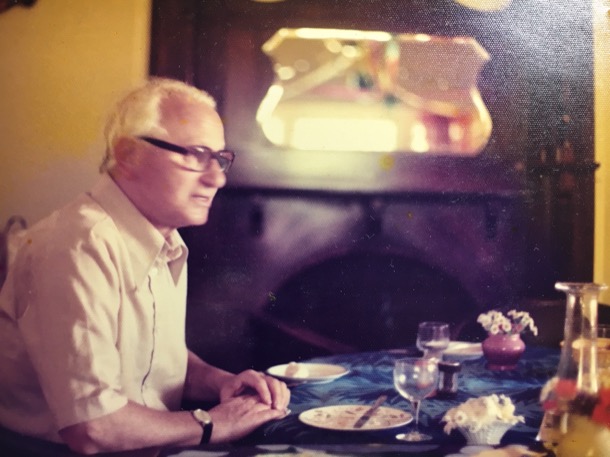
Forty-three years ago and it was a Christmas lunch we would recognise today: similar food and many of the same bowls, cutlery and crockery. Seated around the table are the extended family from both sides, the Danes and teaching friends from overseas.

Two sisters on the verandah at Drouin on Christmas Eve. Margaret’s dog Saki is by her side and Sue is nursing Beetle or Ben.
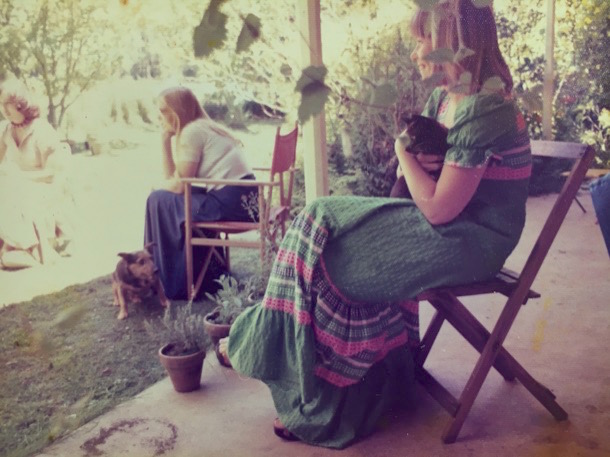
Boxing Day began wth breakfast for house guests and a picnic of leftovers at the Drouin Boxing Day Races. It was a typical hot summer day. Dry grass and eucalypts formed the background to the dusty country track, and the crowd, variously attired in summer race-wear, cheered on the horse races. The largest field in any of the races was only five horses. No fortunes were won or lost and we retired to the cool green garden for a quiet afternoon.

